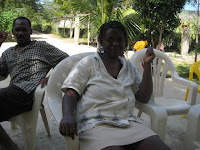Here are updates and links to earthquake impacts and recovery in Haiti. The Mompremiers are pouring the roof on a school they built this summer! Kristie emailed me and reflected that when I was there in January, they had no idea they’d be building a school. They also have a water pump, and a volleyball and basketball court, and have 2 families living with them. I have tentative plans to go down next spring for a week or two to work with their youth group.
The Saturday July 31, 2010 posting on this blog by veterinarian Kelly talks about the tent cities in the capital. Kelly and I talked tentatively about me coming down this fall to help with litter cleanup and manure composting projects she wants to do with youth camps. I’d like to teach the basic science behind these activities. If anyone knows about the trash system in Haiti please let me know! My friend Rhoda who taught me Kreyol this past year moved to Haiti and worked with Kelly’s group CVM for a week before landing a job with Samaritan’s Purse. This is SP’s first time in Haiti.
Here’s an excerpt from Kelley’s blog;
It is raining very hard every afternoon. Ticant's wife just called and asked if they could have another tarp as the rain is pouring in their "tent". The strong sun here makes the tarps and even the tents wear out VERY quickly. There are some of the tarps that are heavier and holding up better but the blue ones like we buy to cover something in the States don't last long at all. It is very hard...
At the camps you have to pay to use the toilet - just imagine if you had diarrhea. The reason for paying is that way the camp committees can pay someone to keep them clean. It's only like 3 goudes but still when you have no job...This is the reality of life in the camps and it sucks! I think though that now some of those who have houses will start to go back. I have heard though that some people are living in the camps who have houses and then are renting their houses to others to make money. I guess I can't blame them. There aren't many free handouts anymore but just being in the mud and so close to so many makes life difficult.











































